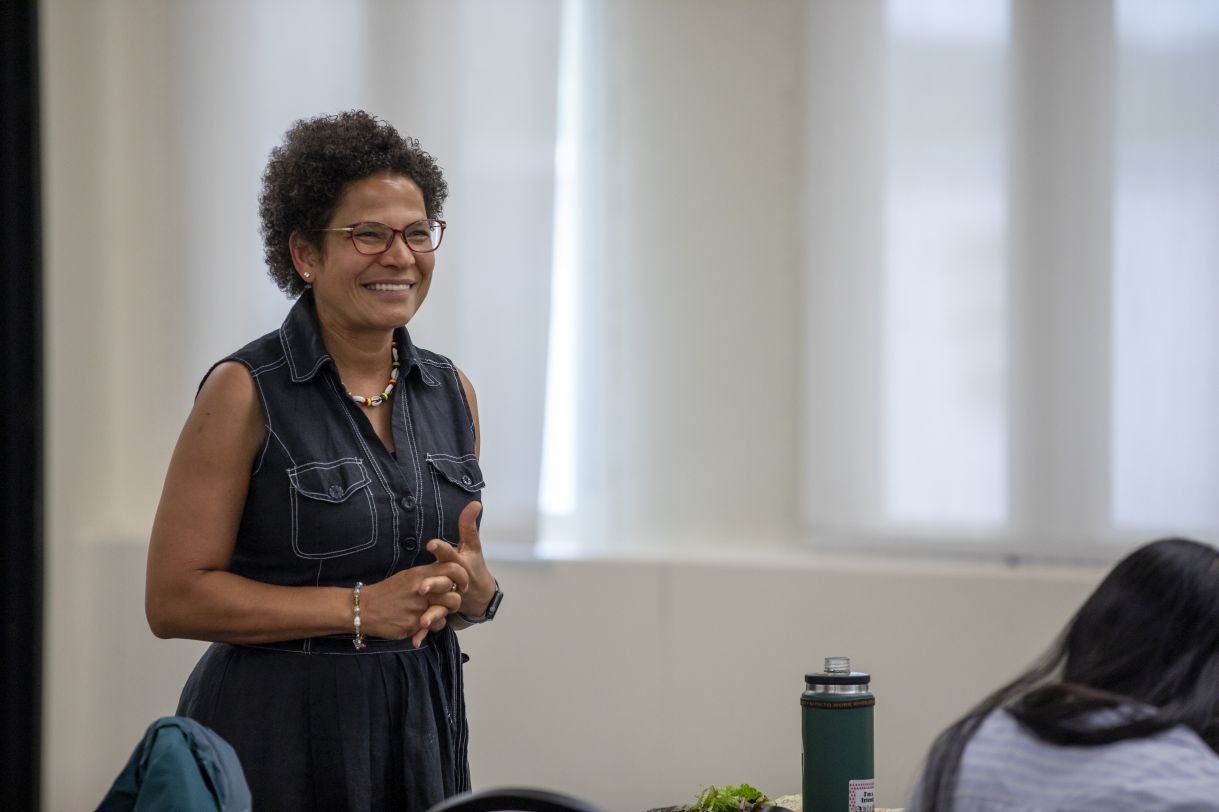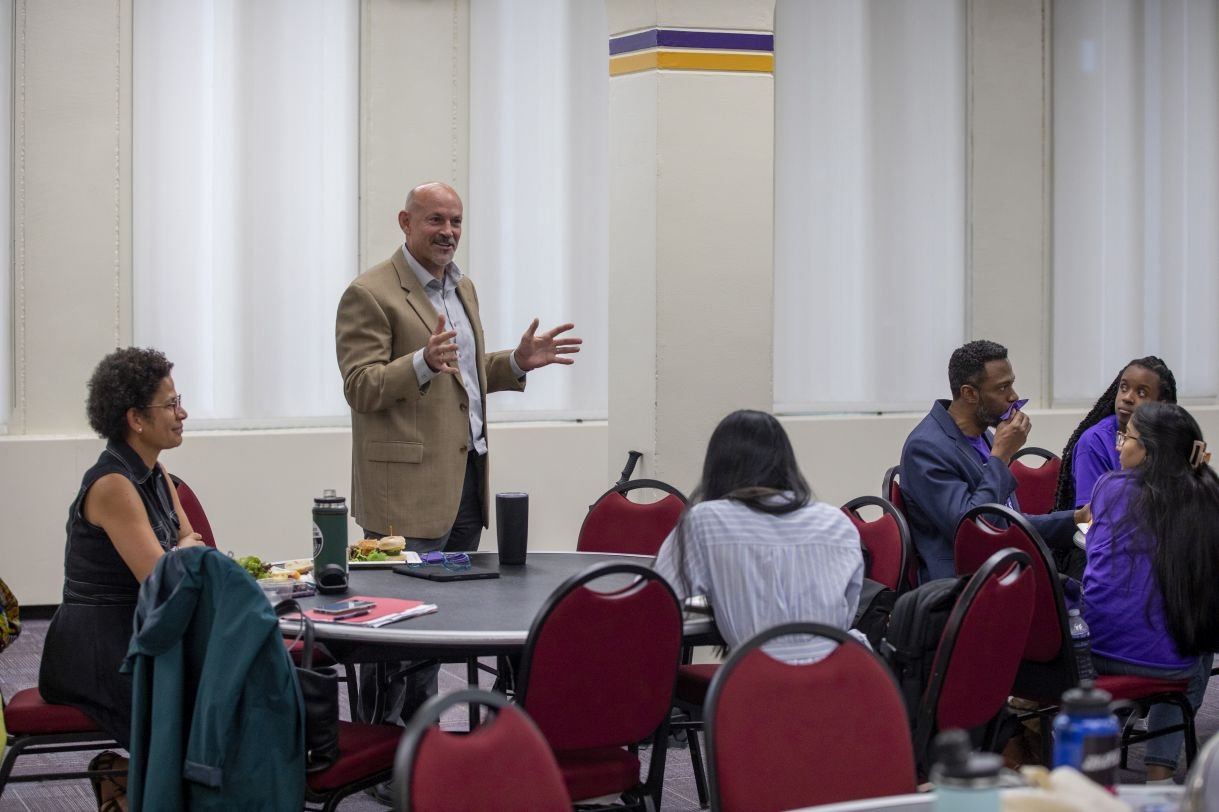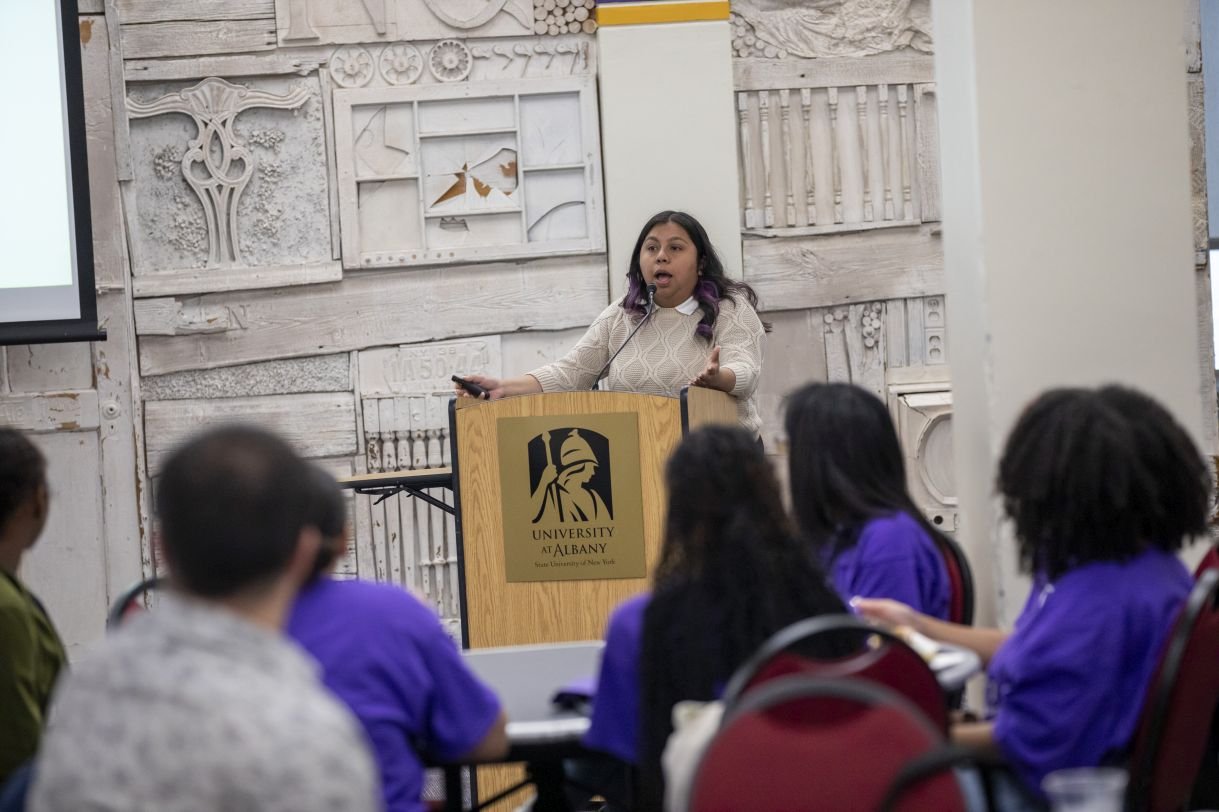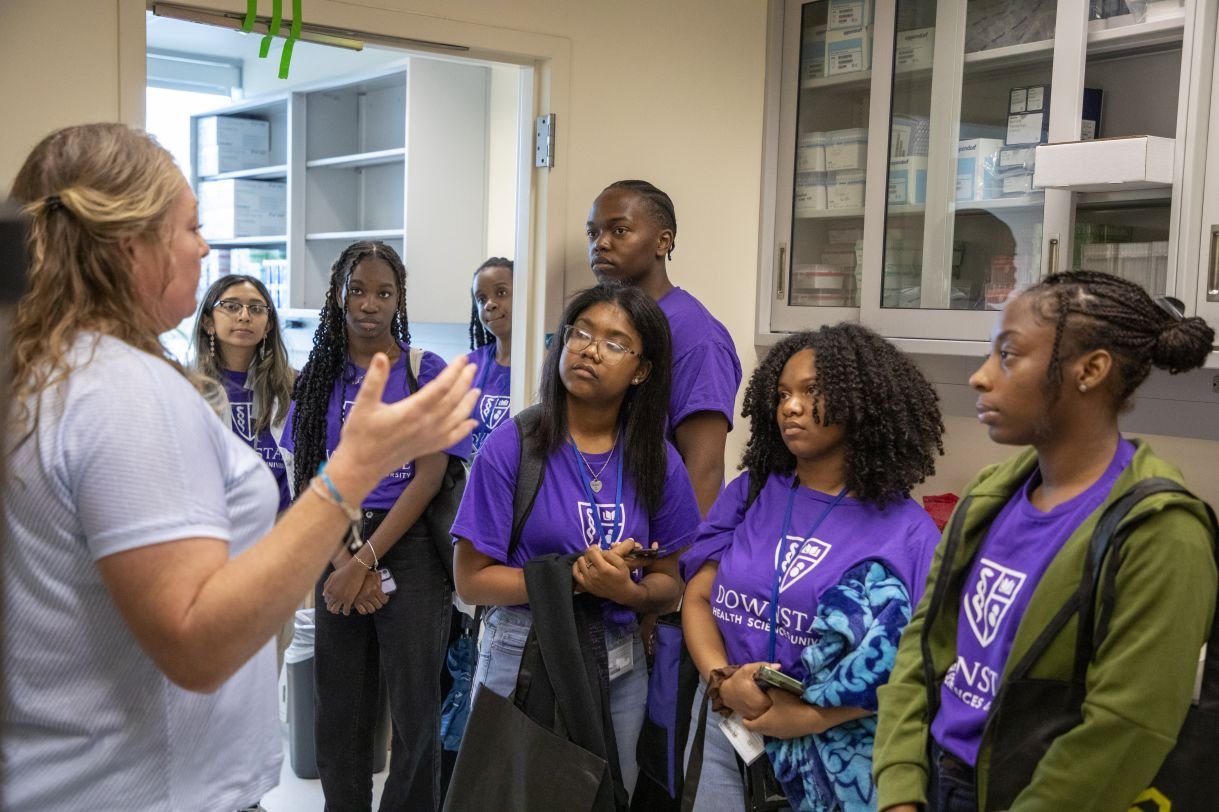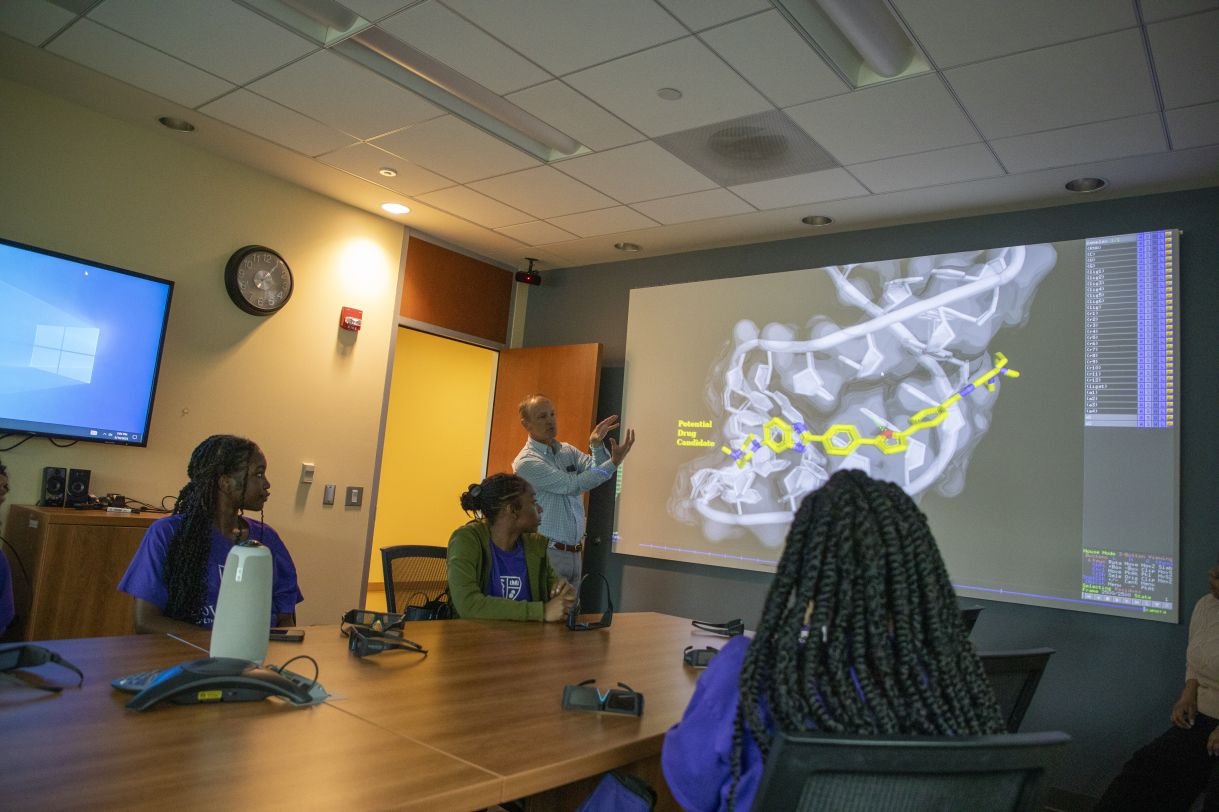UAlbany’s Center for the Elimination of Minority Health Disparities Hosts Summer Research Students
By Erin Frick
ALBANY, N.Y. (July 18, 2023) — University at Albany’s Center for the Elimination of Minority Health Disparities (CEMHD) recently hosted a group of students involved in the Summer Program in Translational Disparities and Community Engaged Research (SPRINTER) offered by SUNY Downstate Health Sciences University, for a day of research presentations and a tour of the RNA Institute.
The SPRINTER program is a summer research experience for undergraduates that combines basic science with health disparities and community-based research. This year’s group of 20 students included participants from institutions including UAlbany, Binghamton University, St. Francis College, Hofstra, Long Island University Brooklyn and CUNY Hunter and Brooklyn, as well as HBCUs Talladega College, Xavier University and Winston Salem State University.
“Central to the CEMHD’s mission is the goal to increase the number and diversity of researchers engaged in scholarship focused on health disparities,” said Annis Golden, director of the CEMHD and associate professor of communication in the College of Arts and Sciences. “UAlbany and SUNY Downstate have a long history of collaboration on various projects in this field, and the annual SPRINTER visit—which offers students in that program a taste of health research underway at UAlbany and introduces them to opportunities for post-graduate study — is an important part of that partnership.”
The SPRINTER group learned about the doctoral fellowship program in health disparities administered by CEMHD, which funds students interested in pursuing health disparities research in any discipline at UAlbany. The fellowship is supported through a $10 million endowment from the National Institute of Minority Health and Health Disparities, as well as a $1 million award from the Hearst Foundations.
There are currently 10 doctoral students participating in this program. Fellows are enrolled in doctoral programs across the University, including Sociology; Latin American, Caribbean and U.S. Latino Studies; Biological and Biomedical Sciences; Anthropology; the School of Social Welfare, and the School of Criminal Justice.
During their visit, the SPRINTER students were welcomed by Golden, Paul Morgan, who directs the new Institute for Social and Health Equity, which now houses the CEMHD, and Elizabeth Vásquez, associate professor in the Department of Epidemiology & Biostatistics at the School of Public Health. Two health disparities doctoral fellows in the Department of Biological Sciences, who are also affiliated with the RNA Institute and supported by the Hearst Foundations award, presented their current research projects to the visiting group.
Health disparities doctoral fellow Esperanza Rosas is a second-year PhD student working with Gabriele Fuchs, assistant professor of biological sciences in the College of Arts and Sciences who is also affiliated with the RNA Institute. Rosas' current research is looking at how RNA modifications influence translation, the process by which information from DNA is used to produce proteins in cells.
“Modifications have been found to be naturally occurring, but also occurring in disease states,” said Rosas. “In order to understand modifications’ impact on translation, we are using chemically synthesized RNAs containing a reporter — in this case, a luminescent tag known as ‘HiBiT’ — and the modification upstream of the coding sequence. By doing so, we can understand their impact on protein synthesis. We have found that changes in the series, in addition to the modification, impact protein synthesis. By studying modification without disease, we can understand translational changes at the basic level.”
Kennedi Weston is a second-year PhD student working with Melinda Larsen, professor of biological sciences who is also affiliated with the RNA Institute. Weston is studying regenerative medicine, with a specific focus on regenerating aged salivary glands, which play a critical role in many of our daily biological functions such as digestion, speech, thermoregulation and olfactory signals.
“My project is focused on understanding how senescence-SASP (senescence-associated secretory phenotype) factors are involved in fibrosis pathology and disease in mouse and human salivary glands,” said Weston. “The opportunity to work with Dr. Larsen has aligned with my passion for cell work and molecular biology.”
Next, the students visited the RNA Institute, where they went on a tour and were treated to a 3D presentation explaining the basics of RNA science and how toxic RNA is targeted to develop disease treatments. The 3D visualization is a tool that the RNA Institute researchers commonly use in projects such as those aiming to develop new small molecules designed to reduce RNA toxicity. RNA Institute Director Andy Berglund addressed the group.
“The RNA Institute enjoys partnering with the CEMHD team to expose SPRINTER students to RNA science that ranges from fundamental biology to developing therapeutic approaches for neuromuscular diseases,” Berglund said. “We look forward to hosting the SPRINTER students and continuing this partnership in the years ahead.”
“It is our hope that by showcasing student presentations and research opportunities in the health sciences, visiting undergraduate students will discover new avenues in health research and perhaps be inspired to undertake a related path in their future careers,” said Golden.
Students seeking doctoral research opportunities in health disparities scholarship are encouraged to visit the program webpage. Interested students may also contact Annis Golden by email to learn more.







